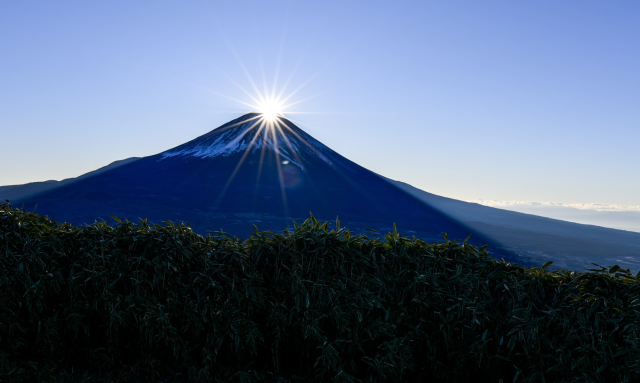
Surveillance camera, alarm installed to discourage the uninformed and unconcerned.
In an ordinary year, we’d be just a few weeks away from the start of Mt. Fuji’s climbing season, with hikers headed up Japan’s tallest mountain to rise above the summer heat and appreciate the country’s natural beauty from a one-of-a-kind vantage point.
2020 has been anything but ordinary, though, with the coronavirus disrupting just about all aspects of life. So instead of officially opening the mountain to hikers on July 10, as had been the plan, the governments of Shizuoka and Yamanashi Prefectures recently announced that Mt. Fuji (which straddles the border between the two prefectures) will be closed to visitors for the entire summer, and in effect the remainder of the year, since the climbing season was scheduled to end on September 10.
They’re serious about the restriction, too. This week Yamanashi’s Fujiyoshida City, where the Yoshida Trail (one of the most popular routes to the peak) starts, installed barricades to prevent hikers from making their way up Fuji’s slopes.
▼ The barricades can be seen in the video here.
富士山に登らないで 山梨県がバリケード設置
— NHKニュース (@nhk_news) June 23, 2020
富士吉田市の登山道に続く県道には、新たに二重のバリケードを設置し、最初のバリケードを突破すると、警告音が流れる警報装置を導入しました。
さらに監視カメラも導入し、モニターで職員が随時チェックしています。https://t.co/0qXA2mA0SG pic.twitter.com/56yVCc4Leq
Two barricades have been set up, with the first checkpoint consisting of metal bars that stretch across the footpath flanked by signs in Japanese, English, and Chinese explaining that the mountain is closed. Should would-be hikers ignore all that, about 30 meters (98 feet) further down the path is a sturdier fence with an alarm that sounds if anyone approaches, while a recording announces “Danger! Do not enter.” The area is also monitored with security cameras.
While the barricades look like they can be pretty easily bypassed with a half-dozen steps off the beaten path and into the underbrush, the purpose of the barricades is less to turn Mt. Fuji into an impregnable fortress and more to remind people that the “do not enter” order is more than just a friendly suggestion. The city also wants to make sure that those who haven’t heard about the hiking ban don’t start making an ascent, and posters explaining that Mt. Fuji is closed for 2020 are also going up at tourist attractions, travel facilities, and outdoor/sporting goods shops in Yamanashi.
Of course, some may argue that you can’t close a mountain, since it’s something that’s there 24-7, regardless of what the authorities say. However, with the mountain closed, none of Mt. Fuji’s mountain huts or first aid stations will be staffed, meaning that shelter, supplies, and emergency aid will be completely unavailable. And while Mt. Fuji is an incredibly popular tourist attraction (the trails get crowded enough for legitimate concerns about the possibility of coronavirus transmission), it’s still a 3,776-meter (12,389-foot) mountain with unpredictable weather and steep drops, that has no problem injuring, or even killing, you if you’re not careful. So really, the best ways to enjoy Fuji this summer are, as suggested by Shizuoka’s governor, to gaze at it from afar and write a poem about it, or maybe to build a model of it like we did.
Source: NHK News Web via Otakomu
Top image: Wikipedia/Gryffindor (edited by SoraNews24)
Insert image: Pakutaso
● Want to hear about SoraNews24’s latest articles as soon as they’re published? Follow us on Facebook and Twitter!
Follow Casey on Twitter, where he can’T write about Yamanashi without craving some Shingen Mochi.


 Mt. Fuji is officially closed for the year
Mt. Fuji is officially closed for the year Mt. Fuji is now open again following 2020 shutdown
Mt. Fuji is now open again following 2020 shutdown Human traffic jam on Mt. Fuji shows why weekdays are the best days to hike the symbol of Japan
Human traffic jam on Mt. Fuji shows why weekdays are the best days to hike the symbol of Japan Hiking restrictions result in huge drop in climbing accidents, with zero on Mt. Fuji
Hiking restrictions result in huge drop in climbing accidents, with zero on Mt. Fuji Mount Fuji plans to start charging compulsory fee to climbers
Mount Fuji plans to start charging compulsory fee to climbers McDonald’s new Happy Meals offer up cute and practical Sanrio lifestyle goods
McDonald’s new Happy Meals offer up cute and practical Sanrio lifestyle goods All-you-can-drink Starbucks and amazing views part of Tokyo’s new 170 meter-high sky lounge
All-you-can-drink Starbucks and amazing views part of Tokyo’s new 170 meter-high sky lounge More foreign tourists than ever before in history visited Japan last month
More foreign tourists than ever before in history visited Japan last month Beautiful Sailor Moon manhole cover coasters being given out for free by Tokyo tourist center
Beautiful Sailor Moon manhole cover coasters being given out for free by Tokyo tourist center Is the new Shinkansen Train Desk ticket worth it?
Is the new Shinkansen Train Desk ticket worth it? Starbucks reopens at Shibuya Scramble Crossing with new look and design concept
Starbucks reopens at Shibuya Scramble Crossing with new look and design concept Hey, Japanese taxi driver! Take us to your favorite restaurant in Tsuruga City!
Hey, Japanese taxi driver! Take us to your favorite restaurant in Tsuruga City! Disney princesses get official manga makeovers for Manga Princess Cafe opening in Tokyo
Disney princesses get official manga makeovers for Manga Princess Cafe opening in Tokyo Arrest proves a common Japanese saying about apologies and police
Arrest proves a common Japanese saying about apologies and police Tokyo’s most famous arcade announces price increase, fans don’t seem to mind at all
Tokyo’s most famous arcade announces price increase, fans don’t seem to mind at all We try out “Chan Ramen”, an underground type of ramen popular in the ramen community
We try out “Chan Ramen”, an underground type of ramen popular in the ramen community Beautiful new Final Fantasy T-shirt collection on the way from Uniqlo【Photos】
Beautiful new Final Fantasy T-shirt collection on the way from Uniqlo【Photos】 Foreign English teachers in Japan pick their favorite Japanese-language phrases【Survey】
Foreign English teachers in Japan pick their favorite Japanese-language phrases【Survey】 There’s a park inside Japan where you can also see Japan inside the park
There’s a park inside Japan where you can also see Japan inside the park Japanese convenience store packs a whole bento into an onigiri rice ball
Japanese convenience store packs a whole bento into an onigiri rice ball Studio Ghibli releases Kiki’s Delivery Service chocolate cake pouches in Japan
Studio Ghibli releases Kiki’s Delivery Service chocolate cake pouches in Japan Japan’s bone-breaking and record-breaking roller coaster is permanently shutting down
Japan’s bone-breaking and record-breaking roller coaster is permanently shutting down New definition of “Japanese whiskey” goes into effect to prevent fakes from fooling overseas buyers
New definition of “Japanese whiskey” goes into effect to prevent fakes from fooling overseas buyers Foreign passenger shoves conductor on one of the last full runs for Japan’s Thunderbird train
Foreign passenger shoves conductor on one of the last full runs for Japan’s Thunderbird train Our Japanese reporter visits Costco in the U.S., finds super American and very Japanese things
Our Japanese reporter visits Costco in the U.S., finds super American and very Japanese things Kyoto bans tourists from geisha alleys in Gion, with fines for those who don’t follow rules
Kyoto bans tourists from geisha alleys in Gion, with fines for those who don’t follow rules Studio Ghibli unveils Mother’s Day gift set that captures the love in My Neighbour Totoro
Studio Ghibli unveils Mother’s Day gift set that captures the love in My Neighbour Totoro Domino’s Japan now sells…pizza ears?
Domino’s Japan now sells…pizza ears? New Japanese KitKat flavour stars Sanrio characters, including Hello Kitty
New Japanese KitKat flavour stars Sanrio characters, including Hello Kitty Sales of Japan’s most convenient train ticket/shopping payment cards suspended indefinitely
Sales of Japan’s most convenient train ticket/shopping payment cards suspended indefinitely Sold-out Studio Ghibli desktop humidifiers are back so Totoro can help you through the dry season
Sold-out Studio Ghibli desktop humidifiers are back so Totoro can help you through the dry season Japanese government to make first change to romanization spelling rules since the 1950s
Japanese government to make first change to romanization spelling rules since the 1950s Ghibli founders Toshio Suzuki and Hayao Miyazaki contribute to Japanese whisky Totoro label design
Ghibli founders Toshio Suzuki and Hayao Miyazaki contribute to Japanese whisky Totoro label design Doraemon found buried at sea as scene from 1993 anime becomes real life【Photos】
Doraemon found buried at sea as scene from 1993 anime becomes real life【Photos】 Tokyo’s most famous Starbucks is closed
Tokyo’s most famous Starbucks is closed One Piece characters’ nationalities revealed, but fans have mixed opinions
One Piece characters’ nationalities revealed, but fans have mixed opinions We asked a Uniqlo employee what four things we should buy and their suggestions didn’t disappoint
We asked a Uniqlo employee what four things we should buy and their suggestions didn’t disappoint Princesses, fruits, and blacksmiths: Study reveals the 30 most unusual family names in Japan
Princesses, fruits, and blacksmiths: Study reveals the 30 most unusual family names in Japan Studio Ghibli’s new desktop Howl’s Moving Castle will take your stationery on an adventure
Studio Ghibli’s new desktop Howl’s Moving Castle will take your stationery on an adventure Search for live-streamer who fell from Mt. Fuji finds badly damaged corpse half-mile below peak
Search for live-streamer who fell from Mt. Fuji finds badly damaged corpse half-mile below peak Fuji Dream Airlines is offering limited Mt. Fuji sightseeing flights
Fuji Dream Airlines is offering limited Mt. Fuji sightseeing flights Photos of “everyday life” in the town next to Mt. Fuji look like a beautiful fantasy world
Photos of “everyday life” in the town next to Mt. Fuji look like a beautiful fantasy world Mt. Fuji jelly makes Japan’s most famous mountain a delight to look at and taste!
Mt. Fuji jelly makes Japan’s most famous mountain a delight to look at and taste! Free Wi-Fi is coming to Mt. Fuji this summer
Free Wi-Fi is coming to Mt. Fuji this summer Hike from the sea to the peak of Mt. Fuji with new bilingual English/Japanese guide map series
Hike from the sea to the peak of Mt. Fuji with new bilingual English/Japanese guide map series Mt. Fuji becomes Studio Ghibli’s Laputa following recent typhoon 【Photos】
Mt. Fuji becomes Studio Ghibli’s Laputa following recent typhoon 【Photos】 Live-streamer who slipped and died on Mt Fuji wins Darwin Award
Live-streamer who slipped and died on Mt Fuji wins Darwin Award Japan’s five easiest-to-get-lost-on mountain trails are like alpine brain teasers【Photos】
Japan’s five easiest-to-get-lost-on mountain trails are like alpine brain teasers【Photos】 Celebrate the arrival of the Mt Fuji climbing season with a mini mountain for cats
Celebrate the arrival of the Mt Fuji climbing season with a mini mountain for cats Peach juice served fresh out the tap at Mt. Fuji Shizuoka Airport
Peach juice served fresh out the tap at Mt. Fuji Shizuoka Airport
Leave a Reply